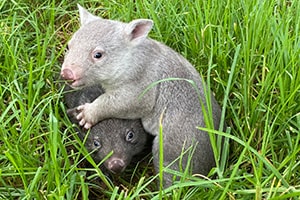Wildlife friendly fencing
Doing some fencing? Make it wildlife friendly!
Each year thousands of animals face a cruel death entangled on barbed wire fences.
Many nocturnal animals like bats, gliders and owls fail to see the fence or cannot clear the height in windy conditions. Over 75 wildlife species have been recorded as fence vicitims, most caught on the top strand.
Kangaroos and emus can get hung up on plain wire and mesh fences. If the fence is too high the animals’ legs can become caught in a twist of wire. Low wires and tension droppers may prevent larger animals from squeezing through the fence.
Wildlife need to move freely and safely across our landscape unless being purposely excluded for safety and other reasons
Designing friendly fences
Stop and think
Do you really need a fence? How will a fence affect the wildlife?
If there are no animals to keep in or out, could a line of native trees do the job?
Avoid barbed wire
When fencing livestock, consider using a combination of plain wire and electric fencing. If using barbed wire, the main issues are fence placement, visibility and type of top strand, especially in entanglement hotspots.
Reduce tangle hotspots
To reduce the risk to wildlife, avoid placing barbed wire fences on ridge lines, near feed trees, across wildlife corridors, over or near water bodies.
To remedy an existing hotspot:
- replace barbs with plain wire
- cover barbs with split polypipe
- make the fence more visible.
Increase visibility
Wire gates are often hard to see and a danger to humans and wildlife. Plastic bags offer a short-term fix. A better way to improve visibility is to use white nylon sighter wires or white electric fence tapes that flicker in the breeze.
A tale of two fences
In the city
Louise lives in the city near a park and found a glider caught on a barbed wire security fence. She worked with the Council to find a solution. The Council replaced the barbed wire with plain wire and planted more trees near the fence to shorten the gliding distance.
High urban fences can be replaced with fences similar to pool fencing. Fences without spikes are a much more wildlife friendly option.
In the country
Geoff, who lives on a rural property with cattle, found a flying-fox caught on his barbed wire fence. The bat had come to feed on a nearby native shrub.
Geoff decided to keep the shrub as it was an important feed tree for various animals. He covered the top two strands of barbed wire near the shrub with polypipe painted white.
What can you do?
- Encourage wildlife friendly fencing in your local area. Talk to neighbours, councils, NRM groups, fencing contractors and suppliers.
- Monitor barbed wire fences in your local area. Report any entangled animals to your local wildlife rescue organisation, found at www.fauna.org.au
Do not approach a trapped animal as it is likely to struggle and do more damage. Where possible, leave the rescue to an experienced carer who will untangle the animal with minimal further injury. Do not handle flying-foxes.
Reproduced with the permission of Tolga Bat Hospital
Newsletter
Stay in touch with our regular rescue stories and WIRES updates.

